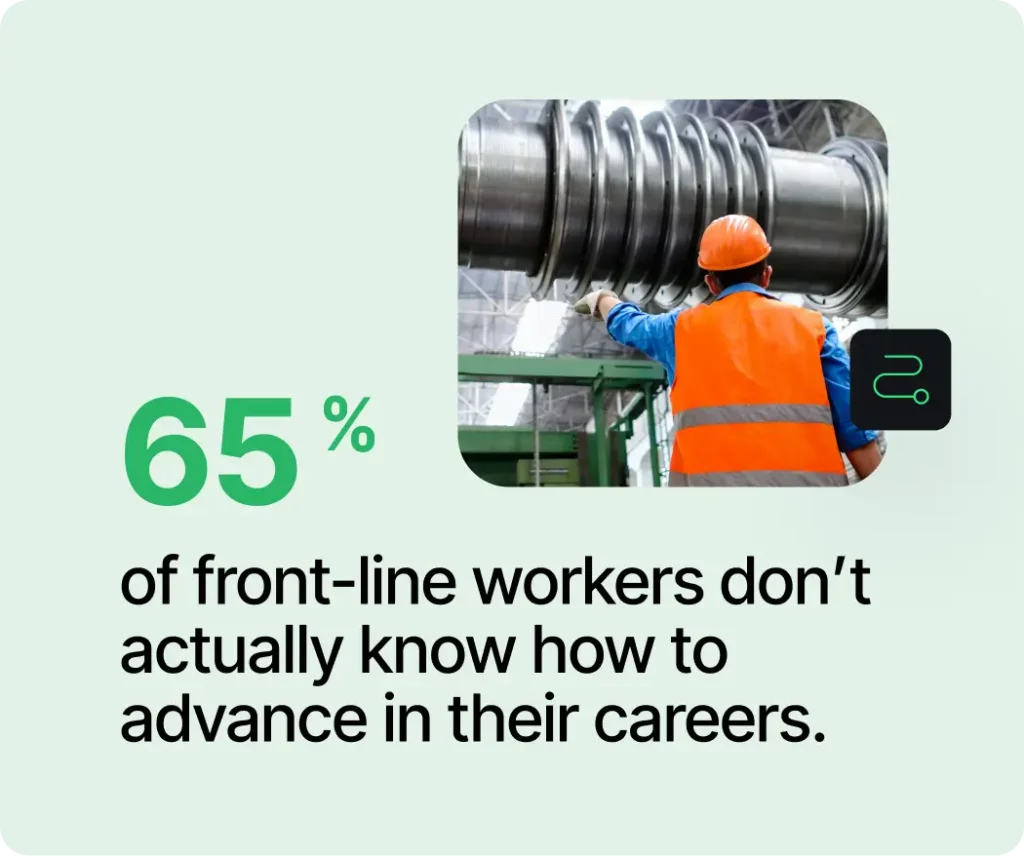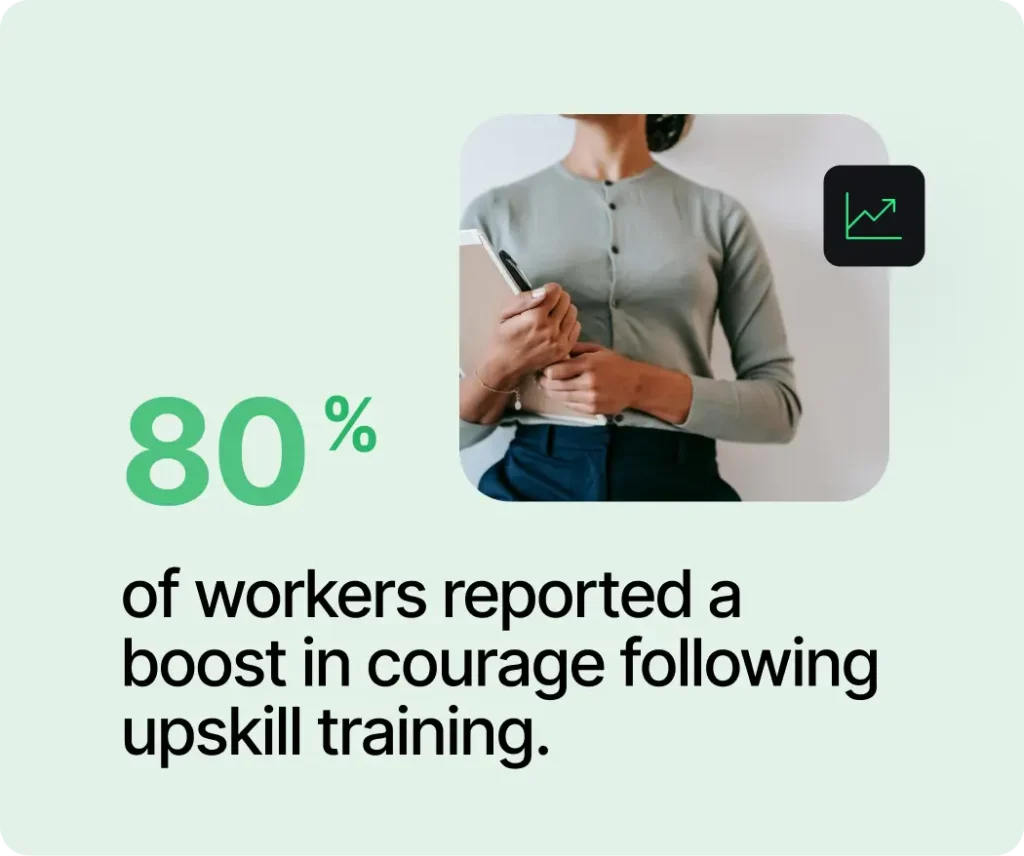- Learning and Development
The Complete Guide To Frontline Employee Training

Frontline employee training is critical because front-line workers are essential—so essential, in fact, that they make up approximately 80% of the global workforce. They’re also a key part of a customer’s decision-making process—59% of customers will stop working with a company after several bad experiences with a front-line worker, while 17% will leave after just one negative interaction.
The truth is that frontline employees aren’t receiving the support they need – and that support begins with effective training. Proper training is vital to increasing front-line worker engagement and retention rates.
Training front-line staff is unique. Employees are often distributed across different locations, have very little onboarding, and don’t have the same luxury of trial and error as other workers. Implementing a robust training program that starts new hires on the right foot can help prepare your business for success.
Here’s where video training comes in. Video offers an efficient, cost-effective solution that can meet the needs of your employees and help your company grow from the ground up.
In this training guide, you will learn:
- Who are Front-line Workers?
- Why are front-line workers important?
- What are the Benefits of Training Front-line Employees?
- What do front-line workers want from training?
- What are the obstacles to training front-line employees?
- How to Effectively Train Front-line Staff
- How to empower front-line employees
- Best practices for training front-line workers with video
- How to Measure the Impact of Front-line Training
- The Future of Front-line Training
Who are frontline workers?
Front-line workers are employees in any industry who provide an essential service to the general public. They are also defined as workers who must physically show up in person to complete their jobs.
Why are frontline workers important?
As essential workers, front-line employees are vital for the proper functioning and maintenance of society. Without front-line workers, we may not be able to have access to some of the fundamental services we require to survive, such as food, healthcare, and a safe place to live.
Front-line employees make up approximately 80% of the global workforce.
What are the benefits of training frontline employees?
There are many benefits to training front-line employees. These benefits include:
- Increasing operational efficiency
- Providing better customer care and service
- Creating a positive company culture
- Increasing employee satisfaction, retention, and empowerment
- Boosting a company’s status as an ideal employer
What do frontline workers want from training?
Now that we’ve explored the benefits of training front-line workers, it’s time to ask what they actually want from training. Why is this important? Because addressing your workers’ needs can increase their motivation and desire to contribute to the continued growth of your company.
In fact, according to the McKinsey and Cara Plus Front-line Employee Survey, having a supportive manager and greater learning opportunities are more important to front-line workers than their employers think. Yet, these elements are often overlooked and can result in employee dissatisfaction.
Here are some ways in which front-line workers want their employers to support them in training:
Restructure traditional employee training for accessibility and efficiency.
Everyone has different schedules, learning abilities, and requirements, and employers have a responsibility to restructure traditional training to support employee’s individual needs.
Whether that means offering short, microlearning videos for busy front-line workers with limited time, adding captions to training videos for workers who may be hard of hearing or want to take notes, or adding on-demand videos for those who want to rewatch the training several times during their lunch break, providing a flexible approach to training is crucial for workers.
Provide greater transparency and communication in your training programs.
Many front-line workers are interested in career advancement. However, they can often face a number of barriers when actually trying to move up the ladder—one of the greatest barriers being a lack of resources and transparency.

In fact, 65% of front-line workers don’t actually know how to advance in their careers. There is an opportunity for employers to communicate with transparency during onboarding—and ongoing training—about the potential career progression available to new hires and the way in which they can get there.
Upskill and cross-skill frontline employees to reflect changing roles.
In tight times, companies often rely on front-line workers to take on new roles. However, they fail to offer upskilling to enable them to do the work successfully. Upskilling not only increases front-line workers’ skill set but also increases their confidence—80% of workers reported a boost in courage following upskill training.

What are the obstacles to training frontline workers?
There can often be obstacles involved in training front-line employees. These include:
- Time
- Turnover
- Personalization
- Buy-in
- Logistics
- Lack of consistency in training
So, what can you do about these obstacles? With effective training and focusing on empowering your staff, you can transform inadequate training into consistent, engaging training that meets the needs of your employees.
How to effectively train frontline employees
It’s more important now than ever to provide effective training for your front-line employees. Inadequate training could result in a lack of engagement, reduced performance, and backlash against your company. As the team members on the ground who closely interact with your customers, insufficient training can also directly impact your bottom line and growth potential.
“Culturally, it’s really important to us that employees feel heard and informed so that they can best serve our membership and our community. As an easy tool that helps us get in front of our team and share key information, Panopto is just perfect for us. We really appreciate the consistency it provides.”
Jayme Bicknell, Marketing Manager at American 1 Credit Union
How to empower front-line workers
Empowering front-line workers is vital not only for morale and retention but also increases workers’ ability to do their jobs successfully.
Here are three ways to empower your front-line workers:
1. Offer flexible training programs.
We have to go with the flow. The majority of people now expect flexibility in their working environment—87% of people would work flexibly if it was an option, according to McKinsey’s American Opportunity Survey.
Flexibility extends to working remotely, training, scheduling, communication methods, and more. For example, it could mean catering to Gen Z and Millennial front-line workers by creating an online portal for job updates to replace an in-person notice board.
2. Remove the corporate barrier.
Often, front-line workers can feel disconnected and isolated from the rest of the company. When no one communicates the company goals to the front line, it can be easy for these employees to lose a feeling of purpose and motivation. By creating a system of internal communication, front-line workers can gain a sense of community, receive recognition, and help support the organization’s mission and vision.
3. Invest in the training tools your workers use.
Have you ever spent hours working on a presentation just to have your computer shut down and not restart because of a software issue? Working with inadequate tools can be frustrating, and the last thing you want to do is make it harder for front-line workers to do their jobs.
Even though 75% of front-line workers globally spend the majority of their time at work using technology, only 40% are happy with the tech their employers provide. Invest in tech that can streamline tasks and make it easier for employees to communicate, and they will feel empowered and supported by your desire to invest in them.
Best practices for training front-line employees with video
As we’ve just explored, investing in the tools your workers use is vital, and one tool that can help employees successfully communicate and streamline tasks is video. These best practices can guide you to develop consistent, effective training using video that strengthens engagement and increases productivity.
1. Ensure consistent front-line training with on-demand content
On-demand and hybrid learning enables employees to easily digest training anytime, anywhere. A great example of on-demand content is video usage, which allows you to meet employees where they are—both in how they learn and how they access training information.
2. Humanize instruction to build culture and rapport
Did you know that more than 60% of deskless workers believe additional training would help them feel better connected to their company’s mission or values? So, how can you add that human element to training? One example is through video training—by having an individual from the company make a recording, you’re adding a face to the training and offering a personal touch. The more human, the better—which means there’s no need to have professionally produced training.
3. Incorporate interactive and personalized training elements to strengthen engagement
Incorporate interactive elements into your training program to elevate engagement, improve knowledge retention, and boost learning outcomes. Examples of this include live demonstrations, group discussions, video quizzes, and virtual polling. Utilizing a video management system and video learning library can assist with the scalability of these features and enable users to personalize their viewing experience and increase interactivity.
In addition, video offers a greater level of accessibility to workers who can utilize tools like captions or watch videos at a slower or faster speed.
4. Measure engagement and outcomes to continuously improve front-line training
Did you know that 70% of organizations do not track quantitative training feedback, and 89% rarely measure training ROI against learning outcomes desired by leadership? Video training opens up a world of data and analytics that help companies understand how employees interact with content.
From individual participation to team-wide learning outcomes, understanding how your workers use your training, what areas they have mastered, and where they can continue to grow can help you shape future courses and professional development opportunities to be as relevant and valuable as possible.
5. Efficiently scale front-line worker training with a video library
A video learning library offers a central, secure, and searchable channel for an organization’s training resources. The best video learning library is one that integrates with existing communication and collaboration tools, offering employees a seamless experience. Rather than in-person training, which can be costly and offer inconsistencies, on-demand videos allow a scalable training process.
How to measure the impact of frontline training
Measuring the impact and ROI of front-line training can be difficult as it needs to go beyond evaluating course completion rates and test scores—it has to demonstrate an influence on business growth. There are four key learning metrics to help you evaluate the business impact. These include:
1. Engagement. How engaged are your front-line staff with your training? Use gamification in training to make it more engaging and fun, and video training analytics such as the number of views on a certain video, how long it was viewed for, and if any comments were added. You can also see the total engagement and where viewing peaked or dropped to determine exactly what people are responding to.
2. Knowledge. Determining if the knowledge of your front-line employees has increased with training. Using interactive tools such as in-video quizzes can help find knowledge gaps, which areas employees are struggling with, and enable you to alter the content as necessary.
3. Behavior. Analyze if there has been a behavioral change in your staff following the training. For example, how has job performance improved over time?
4. Results. Evaluate the impact on business results to help you determine how successful the training has been. This could be in the form of a sales representative exceeding performance expectations or a particular store location beating their quarterly targets, for example.
The future of frontline training
Front-line employees are an important part of a functioning society, and in order to show them recognition, it is vital to continue to assess their needs. That’s where training will continue to expand, with 32.2% of front-line workers saying more training and skill development would motivate them to stay in their current jobs.
The need for growth in training will see more of an emphasis on tech-based solutions such as video technology, automation, and the use of mobile training—and Panopto provides the tool to support these endeavors.



